苏教版小学英语语法大全
苏教版小学英语语法复习要点
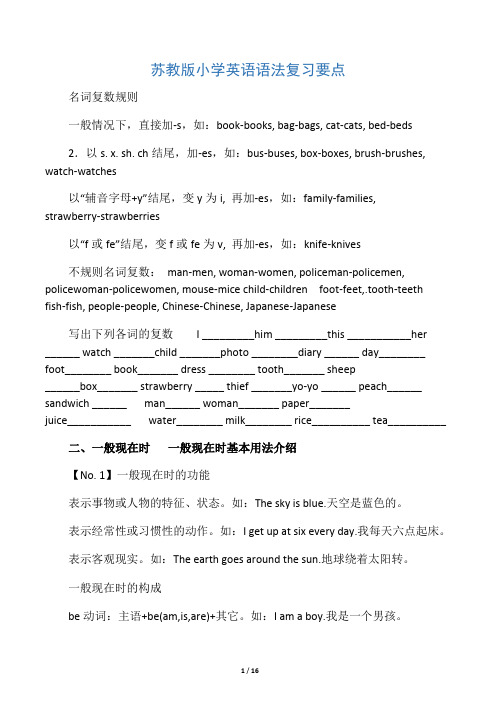
苏教版小学英语语法复习要点名词复数规则一般情况下,直接加-s,如:book-books, bag-bags, cat-cats, bed-beds2.以s. x. sh. ch结尾,加-es,如:bus-buses, box-boxes, brush-brushes, watch-watches以“辅音字母+y”结尾,变y为i, 再加-es,如:family-families,strawberry-strawberries以“f或fe”结尾,变f或fe为v, 再加-es,如:knife-knives不规则名词复数:man-men, woman-women, policeman-policemen, policewoman-policewomen, mouse-mice child-children foot-feet,.tooth-teethfish-fish, people-people, Chinese-Chinese, Japanese-Japanese写出下列各词的复数I _________him _________this ___________her______ watch _______child _______photo ________diary ______ day________ foot________ book_______ dress ________ tooth_______ sheep______box_______ strawberry _____ thief _______yo-yo ______ peach______ sandwich ______ man______ woman_______ paper_______juice___________ water________ milk________ rice__________ tea__________二、一般现在时一般现在时基本用法介绍【No. 1】一般现在时的功能表示事物或人物的特征、状态。
苏教版小学英语语法复习要点

苏教版小学英语语法复习要点一、名词复数规则1.一般情况下,直接加-s,如:book-books, bag-bags, cat-cats, bed-beds2.以s. x. sh. ch结尾,加-es,如:bus-buses, box-boxes, brush-brushes, watch-watches 3.以“辅音字母+y”结尾,变y为i, 再加-es,如:family-families, strawberry-strawberries 4.以“f或fe”结尾,变f或fe为v, 再加-es,如:knife-knives5.不规则名词复数:man-men, woman-women, policeman-policemen, policewoman-policewomen, mouse-mice child-children foot-feet,.tooth-teeth fish-fish, people-people, Chinese-Chinese, Japanese-Japanese写出下列各词的复数I _________him _________this ___________her ______ watch _______child _______photo ________diary ______ day________ foot________ book_______ dress ________ tooth_______ sheep ______box_______ strawberry _____ thief _______yo-yo ______ peach______ sandwich ______ man______ woman_______ paper_______ juice___________ water________ milk________ rice__________ tea__________二、一般现在时一般现在时基本用法介绍【No. 1】一般现在时的功能1.表示事物或人物的特征、状态。
2023年苏教版小学英语语法总复习知识点归纳
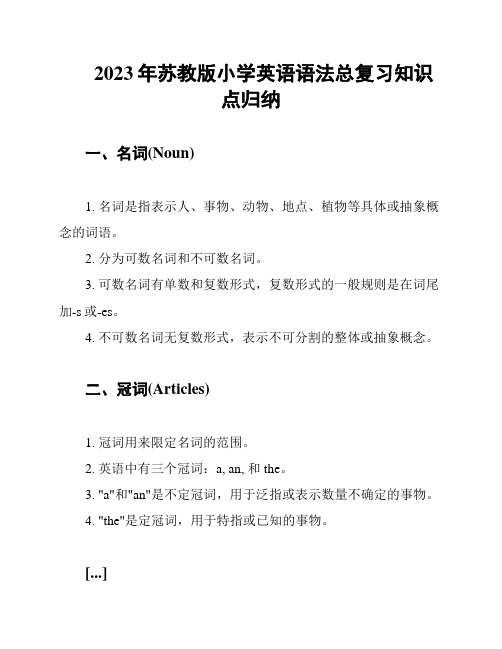
2023年苏教版小学英语语法总复习知识
点归纳
一、名词(Noun)
1. 名词是指表示人、事物、动物、地点、植物等具体或抽象概念的词语。
2. 分为可数名词和不可数名词。
3. 可数名词有单数和复数形式,复数形式的一般规则是在词尾加-s或-es。
4. 不可数名词无复数形式,表示不可分割的整体或抽象概念。
二、冠词(Articles)
1. 冠词用来限定名词的范围。
2. 英语中有三个冠词:a, an, 和 the。
3. "a"和"an"是不定冠词,用于泛指或表示数量不确定的事物。
4. "the"是定冠词,用于特指或已知的事物。
[...]
...
...
七、代词(Pronouns)
1. 代词用来替代名词。
2. 人称代词分为主格和宾格两种形式。
3. 主格代词在句中作主语或断语补足语,宾格代词在句中作动词的宾语、介词的宾语或宾语补足语。
4. 物主代词用来表示所属关系。
5. 反身代词表示动作的发出者与动作的承受者是同一个人。
八、介词(Prepositions)
1. 介词用来表示名词与其他词语之间的关系。
2. 常见的介词有in, on, at, under, over, with, by等。
3. 介词通常位于名词前,构成介词短语。
...
...
(继续补充相关内容至800字以上)。
苏教版小学英语语法复习要点
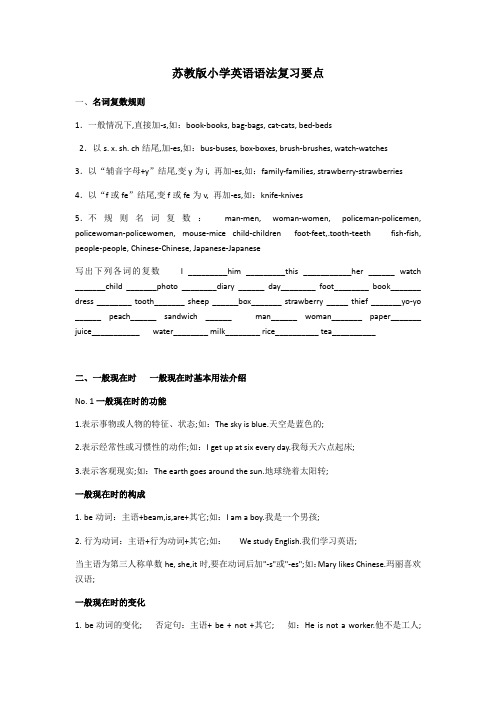
苏教版小学英语语法复习要点一、名词复数规则1.一般情况下,直接加-s,如:book-books, bag-bags, cat-cats, bed-beds2.以s. x. sh. ch结尾,加-es,如:bus-buses, box-boxes, brush-brushes, watch-watches3.以“辅音字母+y”结尾,变y为i, 再加-es,如:family-families, strawberry-strawberries4.以“f或fe”结尾,变f或fe为v, 再加-es,如:knife-knives5.不规则名词复数:man-men, woman-women, policeman-policemen, policewoman-policewomen, mouse-mice child-children foot-feet,.tooth-teeth fish-fish, people-people, Chinese-Chinese, Japanese-Japanese写出下列各词的复数I _________him _________this ___________her ______ watch _______child _______photo ________diary ______ day________ foot________ book_______ dress ________ tooth_______ sheep ______box_______ strawberry _____ thief _______yo-yo ______ peach______ sandwich ______ man______ woman_______ paper_______ juice___________ water________ milk________ rice__________ tea__________二、一般现在时一般现在时基本用法介绍No. 1一般现在时的功能1.表示事物或人物的特征、状态;如:The sky is blue.天空是蓝色的;2.表示经常性或习惯性的动作;如:I get up at six every day.我每天六点起床;3.表示客观现实;如:The earth goes around the sun.地球绕着太阳转;一般现在时的构成1.be动词:主语+beam,is,are+其它;如:I am a boy.我是一个男孩;2.行为动词:主语+行为动词+其它;如:We study English.我们学习英语;当主语为第三人称单数he, she,it时,要在动词后加"-s"或"-es";如:Mary likes Chinese.玛丽喜欢汉语;一般现在时的变化1. be动词的变化; 否定句:主语+ be + not +其它; 如:He is not a worker.他不是工人;一般疑问句:Be +主语+其它; 如:-Are you a student -Yes. I am. / No, I'm not. 特殊疑问句:疑问词+一般疑问句;如:Where is my bike2.行为动词的变化;否定句:主语+ don't doesn't +动词原形+其它;如:I don't like bread.当主语为第三人称单数时,要用doesn't构成否定句;如:He doesn't often play.一般疑问句:Do Does +主语+动词原形+其它;如:- Do you often play football - Yes, I do. / No, I don't.当主语为第三人称单数时,要用does构成一般疑问句;如:- Does she go to work by bike - Yes, she does. / No, she doesn't.特殊疑问句:疑问词+一般疑问句;如:How does your father go to work动词+s的变化规则1.一般情况下,直接加-s,如:cook-cooks, milk-milks2.以s. x. sh. ch. o结尾,加-es,如:guess-guesses, wash-washes, watch-watches, go-goes 3.以“辅音字母+y”结尾,变y为i, 再加-es,如:study-studies 一般现在时用法专练:一、写出下列动词的第三人称单数drink ________ go _______ stay ________ make ________ look _________ have_______ pass_______ carry ____ come________ watch______ plant_______ fly ________ study_______ brush________ do_________ teach_______二、用括号内动词的适当形式填空;1.He often ________have dinner at home.2.Daniel and Tommy _______be in Class One.3.We _______not watch TV on Monday.4.Nick _______not go to the zoo on Sunday.5.______ they ________like the World Cup6.What _______they often _______do on Saturdays7._______ your parents _______read newspapers every day8.The girl _______teach us English on Sundays.9.She and I ________take a walk together every evening.10.There ________be some water in the bottle.11.Mike _______like cooking.12.They _______have the same hobby.13.My aunt _______look after her baby carefully.14.You always _______do your homework well.15. I _______be ill. I’m staying in bed.16.She _______go to school from Monday to Friday.17.Liu Tao _______do not like PE.18.The child often _______watch TV in the evening.19.Su Hai and Su Yang _______have eight lessons this term.20.-What day _______be it today -It’s Saturday.三、按照要求改写句子1.Daniel watches TV every evening.改为否定句___________________________________________________2.I do my homework every day.改为一般疑问句,作否定回答________________________________________________________ ____________3. She likes milk.改为一般疑问句,作肯定回答_______________________________________________________ _______________4. Amy likes playing computer games.改为一般疑问句,作否定回答________________________________________________________ _________________5. We go to school every morning.改为否定句_______________________________________________________6.He speaks English very well.改为否定句___________________________________________________7.I like taking photos in the park.对划线部分提问_______________________________________________________ _______________8.John comes from Canada.对划线部分提问___________________________________________________9.She is always a good student.改为一般疑问句,作否定回答________________________________________________________10.Simon and Daniel like going skating.改为否定句___________________________________________________五、改错划出错误的地方,将正确的写在横线上1.Is your brother speak English __________________2.Does he likes going fishing __________________3.He likes play games after class. __________________4.Mr. Wu teachs us English. __________________5. She don’t do her homework on Sundays. _________________三、现在进行时1.现在进行时表示现在正在进行或发生的动作,也可表示当前一段时间内的活动或现阶段正在进行的动作;2.现在进行时的肯定句基本结构为be+动词ing.3.现在进行时的否定句在be后加not;4.现在进行时的一般疑问句把be动词调到句首;5.现在进行时的特殊疑问的基本结构为:疑问词不达意+ be + 主语+ 动词ing 但疑问词当主语时其结构为:疑问词不达意+ be + 动词ing 但疑问词当主语时其结构为:疑问词不达意+ be + 动词ing 动词加ing的变化规则1.一般情况下,直接加ing,如:cook-cooking2.以不发音的e结尾,去e加ing,如:make-making, taste-tasting3.如果末尾是一个元音字母和一个辅音字母,双写末尾的辅音字母,再加ing,如:run-running, stop-stopping 现在进行时专项练习:一、写出下列动词的现在分词:play________ run__________ swim _________make__________ go_________ like________ write________ _ski___________ read________ have_________ sing ________ dance_________ put_________ see________ buy _________ love____________ live_______ take_________ come ________ get_________ stop_________ sit ________ begin________ shop___________二、用所给的动词的正确形式填空:1.The boy __________________ drawa picture now.2.Listen .Some girls _______________ singin the classroom .3.My mother _________________ cook some nice food now.4.What _____ you ______ do now5.Look . They _______________ have an English lesson .6.They ____________not ,water the flowers now.7.Look the girls ________________dance in the classroom .8.What is our granddaughter doing She _________listen to music.9.It’s 5 o’clock now. We ________havesupper now10.______Helen_____wash clothes Yes ,she is .三、句型转换:1.They are doing housework .分别改成一般疑问句和否定句_____________________________________________________________ _________2.The students are cleaning the classroom . 改一般疑问句并作肯定和否定回答________________________________________________________3.I’m playing the football in the playground .对划线部分进行提问___________________________________________________________4.Tom is reading books in his study . 对划线部分进行提问___________________________________________________________四、将来时理论及练习一、概念:表示将要发生的动作或存在的状态及打算、计划或准备做某事;句中一般有以下时间状语:tomorrow, next dayweek, month, year…,soon, the day after tomorrow后天等; 二、基本结构:①be going to + do;②will+ do.三、否定句:在be动词am, is, arel后加not或情态动词will后加not成won’t; 例如:I’m going to have a picnic this afternoon.→I’m not going to have a picnic this afternoon.四、一般疑问句:be或will提到句首,some改为any, and改为or,第一二人称互换; 例如:We are going to go on an outing this weekend. →Are you going to go on an outing this weekend五、对划线部分提问;一般情况,一般将来时的对划线部分有三种情况;1.问人;Who 例如:I’m going to New York soon. →Who’s going to New York soon.2.问干什么;What …do.例如:My father is going to watch a race with me this afternoon. →What is your father going to do with you this afternoon.3.问什么时候;When.例如:She’s going to go to bed at nine. →When is she going to bed六、同义句:be going to = will I am going to go swimming tomorrow明天. = I will go swimming tomorrow. 填空;1.我打算明天和朋友去野炊; I_____ _______ _________ have a picnic with my friends. I ________ have a picnic with my friends.2. 下个星期一你打算去干嘛我想去打篮球;What ________ ________ _________ _________ _________ next Monday I _______ ___________ play basketball. What _________ you do next Monday I ________ play basketball.3.你妈妈这个周末去购物吗是,她要去买一些水果; _____ your mother _______ ________ go shopping this ___________ Yes, she _________. She ______ ________ __________ buy some fruit.4.5.你们打算什么时候见面; What time _______ you _________ __________meet 改句子;6.Nancy is going to go camping.改否定Nancy ________ going to go camping.7.I’ll go and join them.改否定I _______ go ______ join them.8.I’m going to get up at 6:30 tomorrow.改一般疑问句________ _______ ________ to get up at 6:30 tomorrow9.We will meet at the bus stop at 10:30.改一般疑问句_______ ________ meet at the bus stop at 10:30.10.She is going to listen to music after school.对划线部分提问________ _______ she ________ ________ _________ after school11.My father and mother are going to see a play the day after tomorrow.同上_________ _________ going to see a play the day after tomorrow.用所给词的适当形式填空;12.Today is a sunny day. We ___________________ have a picnic this afternoon.13.My brother _______________ go to Shanghai next week.14.Tom often ______________go to school on foot. But today is rain. He ______________ go to school by bike.15.What do you usually do at weekends I usually __________ watch TV and ____________catch insects16.17.It’s Friday today. What _____she _________ do this weekend She ______________ watch TV and _____________ catch insects.18.What ___________ d0 you do last Sunday I ____________ pick apples on a farm. What ______________ do next Sunday I ______________ milk cows.19.20.Mary ____________ visit her grandparents tomorrow.18. Liu Tao ____________ fly kites in the playground yesterday.19.David ______________ give a puppet show next Monday. 20. I ________________ plan for my study now.五、一般过去时1.一般过去时表示过去某个时间发生的动作或存在的状态,常和表示过去的时间状语连用;一般过去时也表示过去经常或反复发生的动作感谢;2.Be动词在一般过去时中的变化:⑴am 和is在一般过去时中变为was;was not=wasn’t ⑵are在一般过去时中变为were;were not=weren’t ⑶带有was或were的句子,其否定、疑问的变化和is, am, are一样,即否定句在was或were后加not,一般疑问句把was或were调到句首;3.句中没有be动词的一般过去时的句子否定句:didn’t +动词原形,如:Jim didn’t go home yesterday. 一般疑问句:在句首加did,句子中的动词过去式变回原形; 如:Did Jim go home yesterday 特殊疑问句:⑴疑问词+did+主语+动词原形如:What did Jim do yesterday⑵疑问词当主语时:疑问词+动词过去式如:Who went to home yesterday动词过去式变化规则:1.一般在动词末尾加-ed,如:pull-pulled, cook-cooked2.结尾是e加d,如:taste-tasted3.末尾只有一个元音字母和一个辅音字母的重读闭音节,应双写末尾的辅音字母,再加-ed,如:stop-stopped4.以“辅音字母+y”结尾的,变y为i, 再加-ed,如:study-studied写出下列动词的过去式is\am_________ fly_______ plant________ are ________ drink_________ play_______ go________ make ________ does_________ dance________ worry________ ask _____ taste_________ eat__________ draw________ put ______ throw________ kick_________ pass_______ do ________Be动词的过去时练习1 一、用be动词的适当形式填空1.I _______ at school just now.2.He ________ at the camp last week.3.We ________ students two years ago.4.They ________ on the farm a moment ago.5.Yang Ling ________ eleven years old last year.6. There ________ an apple on the plate yesterday. 7. There ________ some milk in the fridge on Sunday.8.The mobile phone _______ on the sofa yesterday evening.二、句型转换1.It was exciting.否定句:________________________________________________一般疑问句:____________________________________________肯、否定回答:__________________________________________2.All the students were very excited.否定句:________________________________________________一般疑问句:____________________________________________肯、否定回答:__________________________________________3.They were in his pocket.否定句:________________________________________________一般疑问句:____________________________________________肯、否定回答:__________________________________________Be 动词的过去时练习2一、用be动词的适当形式填空1.I ______ an English teacher now.2. She _______ happy yesterday.3.They _______ glad to see each other last month.4.Helen and Nancy ________ good friends.5.The little dog _____ two years old this year.6.Look, there ________ lots of grapes here.7.There ________ a sign on the chair on Monday..8.Today _____ the second of June. Yesterday ______ the first of June. It _____ Children’s Day. All the students ______ very excited.二、句型转换1.There was a car in front of the house just now.否定句:________________________________________________一般疑问句:____________________________________________肯、否定回答:__________________________________________肯、否定回答:__________________________________________三、中译英1.我的故事书刚才还在手表旁边;___________________________________________________________2.他们的外套上个礼拜放在卧室里了;3.一会以前花园里有两只小鸟;___________________________________________________________ 行为动词的过去时练习1一、用行为动词的适当形式填空1.He _________ live in Wuxi two years ago.2.The cat ________ eat a bird last night.3.We _______ have a party last Halloween.4.Nancy ________ pick up oranges on the farm last week.5.I ________ make a model ship with Mike yesterday.6.They ________ play chess in the classroom last PE lesson.7.My mother _______ cook a nice food last Spring Festival.8.The girls ________ sing and _______ dance at the party.二、句型转换1. Su Hai took some photos at the Sports day.否定句:________________________________________________一般疑问句:____________________________________________肯、否定回答:_________________________________________ _2.Nancy went to school early.否定句:________________________________________________一般疑问句:____________________________________________肯、否定回答:__________________________________________3.We sang some English songs.否定句:________________________________________________一般疑问句:____________________________________________肯、否定回答:__________________________________________行为动词的过去时练习一、用be动词的适当形式填空1.I ______ watch a cartoon on Saturday.2.Her father _______ read a newspaper last night.3.We _________ to zoo yesterday, we _____ to the park. go4.______ you _______ visit your relatives last Spring Festival5.______ he _______ fly a kite on Sunday Yes, he ______.6.Gao Shan _______ pull up carrots last National Day holiday.7.I ____________ sweep the floor yesterday, but my mother ______.8.What ______ she _______ find in the garden last morning She __________ find a beautiful butterfly.二、句型转换1.They played football in the playground.否定句:________________________________________________一般疑问句:____________________________________________肯、否定回答:__________________________________________2.We sang some English songs.否定句:________________________________________________一般疑问句:____________________________________________肯、否定回答:__________________________________________二、中译英1. 格林先生去年住在中国;2. . 昨天我们参观了农场;3. 他刚才在找他的手机;过去时综合练习1一、用动词的适当形式填空1.It ______ be Ben’s birthday last Friday.2.. We all ______ have a good time last night.3.He ________ jump high on last Sports Day.4.Helen ________ milk a cow on Friday.5.She likes ______ newspapers, but she ______ a book yesterday. read6.He _______ football now, but they _______ basketball just now. play7.Jim’s mother _________ plant trees just now.8._______ they ________ sweep the floor on Sunday No, they _____.9. I _______ watch a cartoon on Monday. 10. We ___________ go to school on Sunday 1.我们上周五看了一部电影;_________________________________________________________2.他上个中秋节走亲访友了吗是的;_________________________________________________________3.你们上个儿童节做了什么我们参观了动物园;_________________________________________________________4. 你上周在哪儿在野营基地;_________________________________________________________过去时综合练习2一、用动词的适当形式填空1.It _____ be the 2nd of November yesterday Mr White ________ go to his office by car.2.Gao Shan ________ put the book on his head a moment ago.3.Don’t ______ the house. Mum _______ it yesterday. clean4.What ____ you ______ just now I _______ some housework. do5.They _________ make a kite a week ago.6.I want to ______ apples. But my dad _______ all of them last month. pick7._______ he ______ the flowers this morning Yes, he _____. water8. She ____ be a pretty girl. Look, she _____ do Chinese dances.9. The students often _________ draw some pictures in the art room. 10.What ______ Mike do on the farm He ________ cows. milk二、中译英1.他的朋友在照看他的弟弟;_________________________________________________________2. 去年端午节我们没去看了龙舟比赛;_________________________________________________________3.他在音乐课上拉小提琴了吗不,没有;________________________________________________。
(完整版)苏教版牛津小学英语语法点汇总(参考)
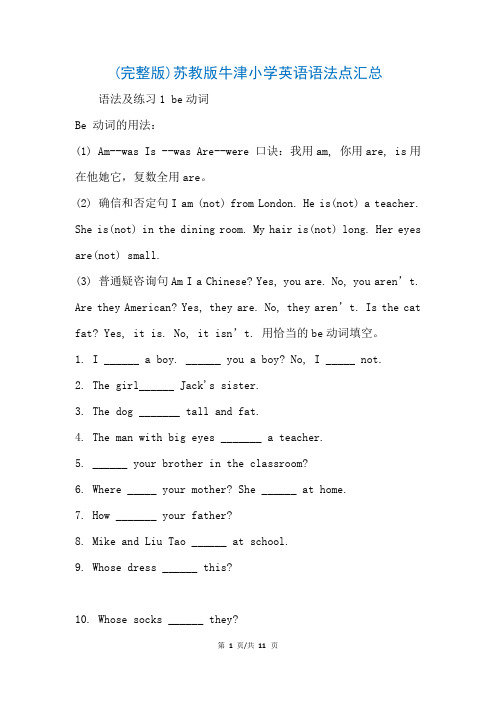
(完整版)苏教版牛津小学英语语法点汇总语法及练习1 be动词Be 动词的用法:(1) Am--was Is --was Are--were 口诀:我用am, 你用are, is用在他她它,复数全用are。
(2) 确信和否定句I am (not) from London. He is(not) a teacher. She is(not) in the dining room. My hair is(not) long. Her eyes are(not) small.(3) 普通疑咨询句Am I a Chinese? Yes, you are. No, you aren’t. Are they American? Yes, they are. No, they aren’t. Is the cat fat? Yes, it is. No, it isn’t. 用恰当的be动词填空。
1. I ______ a boy. ______ you a boy? No, I _____ not.2. The girl______ Jack's sister.3. The dog _______ tall and fat.4. The man with big eyes _______ a teacher.5. ______ your brother in the classroom?6. Where _____ your mother? She ______ at home.7. How _______ your father?8. Mike and Liu Tao ______ at school.9. Whose dress ______ this?10. Whose socks ______ they?11. That ______ my red skirt.12. Who ______ I?13.The jeans ______ on the desk.14. Here ______ a scarf for you.15. Here ______ some sweaters for you.16. The black gloves ______ for Su Yang.17. This pair of gloves ______ for Yang Ling.18. The two cups of milk _____ for me.19. Some tea ______ in the glass.20. Gao shan's shirt _______ over there.21. My sister's name ______Nancy.22. This ______ not Wang Fang's pencil.23. ______ David and Helen from England?24. There ______ a girl in the room.25. There ______ some apples on the tree.26. _______ there any kites in the classroom?27. _______ there any apple juice in the bottle?28. There _______ some bread on the plate.29. There _______ a boy, two girls, three men and ten women in the park.30. You, he and I ______ from China.语法及练习2 人称代词和物主代词人称代词和物主代词1.人称代词主格和宾格的区不:主格通常位于句中第一具动词之前(有时候位于than 之后),宾格普通位于动词或介词之后。
(完整版)苏教版本1-6年级英语语法复习要点
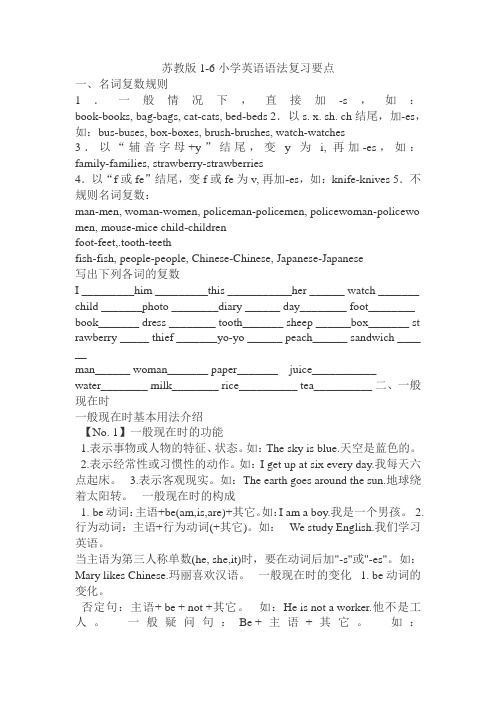
苏教版1-6小学英语语法复习要点一、名词复数规则1.一般情况下,直接加-s,如:book-books, bag-bags, cat-cats, bed-beds 2.以s. x. sh. ch结尾,加-es,如:bus-buses, box-boxes, brush-brushes, watch-watches3.以“辅音字母+y”结尾,变y为i, 再加-es,如:family-families, strawberry-strawberries4.以“f或fe”结尾,变f或fe为v, 再加-es,如:knife-knives 5.不规则名词复数:man-men, woman-women, policeman-policemen, policewoman-policewo men, mouse-mice child-childrenfoot-feet,.tooth-teethfish-fish, people-people, Chinese-Chinese, Japanese-Japanese写出下列各词的复数I _________him _________this ___________her ______ watch _______ child _______photo ________diary ______ day________ foot________ book_______ dress ________ tooth_______ sheep ______box_______ st rawberry _____ thief _______yo-yo ______ peach______ sandwich ____ __man______ woman_______ paper_______ juice___________water________ milk________ rice__________ tea__________ 二、一般现在时一般现在时基本用法介绍【No. 1】一般现在时的功能1.表示事物或人物的特征、状态。
苏教版小学英语语法复习要点

苏教版小学英语语法复习要点TTA standardization office【TTA 5AB- TTAK 08- TTA 2C】苏教版小学英语语法复习要点一、名词复数规则1.一般情况下,直接加-s,如:book-books, bag-bags, cat-cats, bed-beds2.以s. x. sh. ch结尾,加-es,如:bus-buses, box-boxes, brush-brushes, watch-watches 3.以“辅音字母+y”结尾,变y为i, 再加-es,如:family-families, strawberry-strawberries4.以“f或fe”结尾,变f或fe为v, 再加-es,如:knife-knives5.不规则名词复数: man-men, woman-women, policeman-policemen, policewoman-policewomen, mouse-mice child-children foot-feet,.tooth-teeth fish-fish, people-people, Chinese-Chinese, Japanese-Japanese写出下列各词的复数 I _________him _________this ___________her ______ watch_______child _______photo ________diary ______ day________ foot________book_______ dress ________ tooth_______ sheep ______box_______ strawberry _____ thief _______yo-yo ______ peach______ sandwich ______ man______ woman_______ paper_______ juice___________ water________ milk________ rice__________tea__________二、一般现在时一般现在时基本用法介绍【No. 1】一般现在时的功能1.表示事物或人物的特征、状态。
小升初苏教版3-6年级小学英语语法大全-经典全面
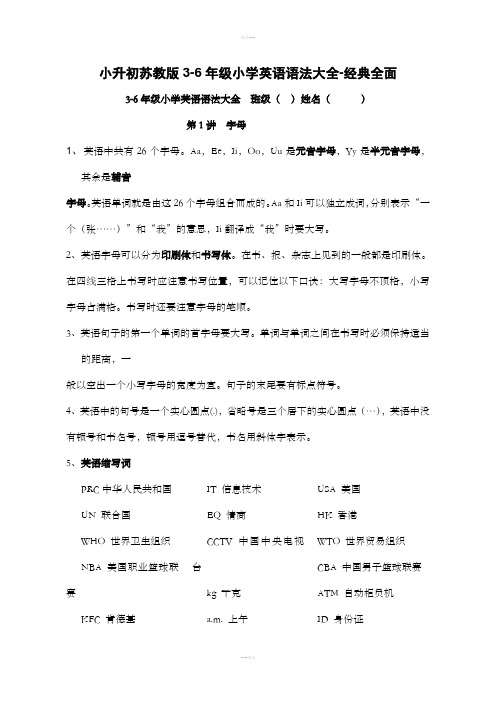
小升初苏教版3-6年级小学英语语法大全-经典全面3-6年级小学英语语法大全班级()姓名()第1讲字母1、英语中共有26个字母。
Aa,Ee,Ii,Oo,Uu是元音字母,Yy是半元音字母,其余是辅音字母。
英语单词就是由这26个字母组合而成的。
Aa和Ii可以独立成词,分别表示“一个(张……)”和“我”的意思,Ii翻译成“我”时要大写。
2、英语字母可以分为印刷体和书写体。
在书、报、杂志上见到的一般都是印刷体。
在四线三格上书写时应注意书写位置,可以记住以下口诀:大写字母不顶格,小写字母占满格。
书写时还要注意字母的笔顺。
3、英语句子的第一个单词的首字母要大写。
单词与单词之间在书写时必须保持适当的距离,一般以空出一个小写字母的宽度为宜。
句子的末尾要有标点符号。
4、英语中的句号是一个实心圆点(.),省略号是三个居下的实心圆点(…),英语中没有顿号和书名号,顿号用逗号替代,书名用斜体字表示。
5、英语缩写词PRC中华人民共和国UN 联合国WHO 世界卫生组织NBA美国职业篮球联赛KFC 肯德基IT 信息技术EQ 情商CCTV 中国中央电视台kg 千克a.m. 上午USA 美国HK 香港WTO 世界贸易组织CBA 中国男子篮球联赛ATM 自动柜员机ID 身份证CPU 中央处理器BBC 英国广播公司cm 厘米p.m. 下午UK 英国SOS 国际求救信号UFO 不明飞行物VIP 贵宾EMS邮政特快专递IQ 智商RMB 人民币VOA 美国之音No. 号码6、26个英语字母按照相同的元音因素进行归类:1、音素:语音的最小单位。
英语中共有48个音素,其中元音音素20个,辅音音素28个。
/i:/,/ɪ/,/ɜ:/,/ə/,/ɑ:/,//,/ɔ:/,/ɒ/,/u:/,/ʊ/,/e/,/æ//p/,/t/,/k/,/t/,/tr/,/ts/,/f/,/θ/,/s/,/∫/,/h/2单元音发音时唇形和舌位不变;双元音发音时由一个元音向另一个元音滑动,唇形和舌位有一个变化过程,且前重后轻,前长后短。
苏教版【五年级】英语语法知识汇总(全)

苏教版【五年级】英语语法知识汇总(全)2、人称代词和物主代词人称代词:有主格和宾格之分。
一般动词前用主格,动词后用宾格。
3、指示代词4、冠词有a、an、the。
a和an的区别:an用于元音音素(一般就是元音字母a、e、i、o、u)前,a用于辅音音素前。
二、否定句:be动词(am、is、are)+not、情态动词can+ not、助动词(do、does) + not如何将一个肯定的陈述句改为否定句:1、看句中有无be动词,如有,直接在be动词后+ not。
2、看句中有无情态动词,如有,直接在情态动词后+ not。
3、如上述二者都没有,就应用助动词+ not。
分四个步骤:(1)肯定陈述句中本来是没有助动词的,要加上去,位置在主语(某人或某物)后,动词前。
(2)确定助动词用do、does,根据句中动词,动词是原形的助动词就用do,动词是第三人称单数的助动词就用does,(3)在助动词后加not。
(4)原句中动词假如发生变化就要恢复成原形。
强调一点,有some的要考虑是否要用any。
三、一般疑问句。
如何将一个肯定的陈述句改为一般疑问句:1、看句中有无be动词,如有,把be动词提到句首即可。
2、看句中有无情态动词,如有,把情态动词提到句首即可。
3、如上述二者都没有,就应把助动提到句首。
分四个步骤:(1)肯定陈述句中本来是没有助动词的,要加上去,位置在主语(某人或某物)后,动词前。
I do like you.(2)确定助动词用do还是does,根据句中动词,动词是原形的助动词就用do,动词是第三人称单数的助动词就用doesHe does like you.(3)把助动词后提到句首。
Does he like you?(4)原句中动词假如发生变化就要恢复成原形。
强调一点,有some的要考虑是否要用any。
四、特殊疑问句。
表示疑问,有疑问词(在开头),回答有很多种可能。
常用疑问词:五、时态1、一般现在时:表示某动作或者某状态是经常发生的事情,或者是自然规律。
苏教版【五年级】英语语法知识汇总(全)(完美版)
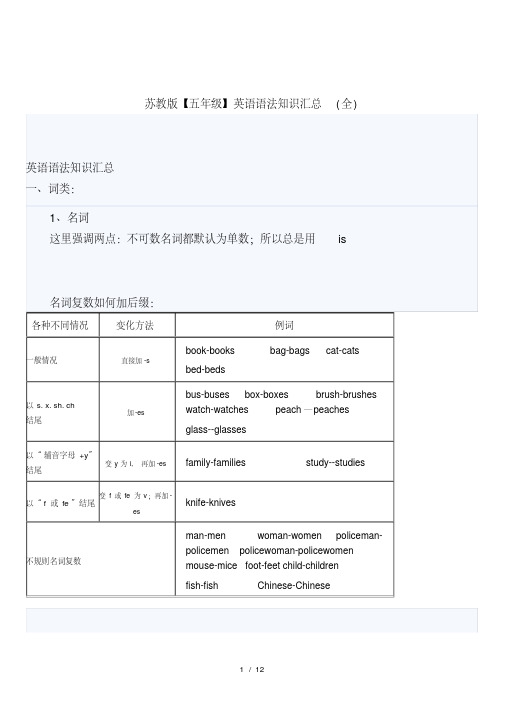
苏教版【五年级】英语语法知识汇总(全)英语语法知识汇总一、词类:1、名词这里强调两点:不可数名词都默认为单数;所以总是用is名词复数如何加后缀:各种不同情况变化方法例词一般情况直接加-s book-books bag-bags cat-cats bed-beds以s. x. sh. ch 结尾加-esbus-buses box-boxes brush-brusheswatch-watches peach—peachesglass--glasses以“辅音字母+y”结尾变y为i, 再加-es family-families study--studies以“f或fe”结尾变f或fe为v;再加-esknife-knives不规则名词复数man-men woman-women policeman-policemen policewoman-policewomen mouse-mice foot-feet child-childrenfish-fish Chinese-Chinese2、人称代词和物主代词人称代词物主代词单数复数单数复数主格宾格主格宾格形容词性形容词性第一人称I(我)me we(我们)us my(我的)our(我们的)第二人称you(你)you you(你们)you your(你的) your(你们的)第三人称he(他)himthey(他/她/它们)themhis(他的)their(他/她/它们的)she(她)her her(她的)it(它)it it(它的)人称代词:有主格和宾格之分.一般动词前用主格;动词后用宾格.3、指示代词4、冠词有a、an、the.a和an的区别:an用于元音音素(一般就是元音字母a、e、i、o、u)前;a用于辅音音素前.二、否定句:be动词(am、is、are)+not、情态动词can+ not、助动词(do、does) + not如何将一个肯定的陈述句改为否定句:1、看句中有无be动词;如有;直接在be动词后+ not.2、看句中有无情态动词;如有;直接在情态动词后+ not.3、如上述二者都没有;就应用助动词+ not.分四个步骤:(1)肯定陈述句中本来是没有助动词的;要加上去;位置在主语(某人或某物)后;动词前.(2)确定助动词用do、does;根据句中动词;动词是原形的助动词就用do;动词是第三人称单数的助动词就用does;(3)在助动词后加not.(4)原句中动词假如发生变化就要恢复成原形.强调一点;有some的要考虑是否要用any.三、一般疑问句.如何将一个肯定的陈述句改为一般疑问句:1、看句中有无be动词;如有;把be动词提到句首即可.2、看句中有无情态动词;如有;把情态动词提到句首即可.3、如上述二者都没有;就应把助动提到句首.分四个步骤:(1)肯定陈述句中本来是没有助动词的;要加上去;位置在主语(某人或某物)后;动词前.I do like you.(2)确定助动词用do还是does;根据句中动词;动词是原形的助动词就用do;动词是第三人称单数的助动词就用doesHe does like you.(3)把助动词后提到句首.Does he like you?(4)原句中动词假如发生变化就要恢复成原形.强调一点;有some的要考虑是否要用any.四、特殊疑问句.表示疑问;有疑问词(在开头);回答有很多种可能.常用疑问词:疑问词意思用法What time 什么时间问具体时间;如几点钟Who 谁问人Whose 谁的问主人Where 在哪里问地点What 什么问东西、事物What colour 什么颜色问颜色How old 多大年纪问年纪How many 多少数量(可数名词)问数量How much 多少钱;多少数量(不可数名词)问多少钱或数量(不可数)五、时态1、一般现在时:表示某动作或者某状态是经常发生的事情,或者是自然规律.?主语+be动词(am, is , are)?主语+动词原形(注意动词要根据主语变三单)(1)一般现在时中的be动词:一般用原形:am is aream用于第一人称单数(I);is用于第三人称单数(he she it和其他人名或称谓;如:Ben his sister等);are用于第二人称单数(you)和所有复数(包括第一人称复数we、第二人称复数you;第三人称复数they和其他复数;如the children 、 his parents等).(2)一般现在时中的动词:第一种情况:主语是第三人称单数(he she it 和其他;如Helen 、her cousin 等);动词后一般加s或es.第二种情况:主语不是第三人称单数;动词都用原形.(4)一般现在时判断依据(如何判断一个句子是一般现在时):△be动词是am、is、are △动词用原形或加s、es△没有时间状语或有usually、often、everyday、sometimes等不是具体的时间2、现在进行时(1)构成形式:Be动词+动词的ing形式这里强调一点;两者缺少其中任何一种都不可以构成现在进行时.(2)现在进行时表示动作正在进行或事情正在发生.(3)有用的依据:一个句子中既有be动词;又有动词;且动词加了ing ←→该句是现在进行时(4)句中往往有now、look、listen等词.动词现在分词的变化见下表:同音词: too---two----to buy---by I---eye four----for there----their right----write sun----son no----knowhere---hear who’s----whose近义词:many----a lot of / lots of large----big desk----table photo---picture lamp----light like----love反义词或对应词:old----new big----smallopen----close black----white here----there完整形式:let’s=let us(让我们) I’d=I wouldcan’t=can not I’m=I am词性变换:one(序数词) first monkey(复数)monkeys skiing(原形)ski is(复数)are families(单数)family make(现在分词)making we are(缩略形式)we’re do(第三人称单数)does have(第三人称单数)hasphoto(复数)photos fat(反义词)thin★做题目时一定要记住:1.can+动词原形2.like+动词ing3.like+名词复数4.play+足球类 play the +乐器类5.how many +名词复数6.would like +to+动词原形7.let's+动词原形8.现在进行时:be(am,is,are)+动词ing9.动词第三人称单数形式英语音标及字母组合对照元音: 1) [i:] 字母组合:ee ea e ie ei eythree tree green sheep meet beef see seekeat tea meat leave lead teacher team mean speak clean pleasehe she mepiece receive ceiling2)[ I ]发音字母 i y e ui u asit picture it is list six mix fix fit pig big build missmyth many twenty happy dictionarydefect decide delicious3) [ ? ] 发音字母 abag hand and ant happy hat map mad bad black back glad flag shall man4) [e] 字母组合 ea e a (ue,u,ie,ai,ei,ay)head bread pleasureelephant electric remember sell shell lesson better bed desk hotel yesmany any5) [ε:] 字母组合ir ur ear er orgirl shirt skirt thirty thirteen third birdturn burn murder nurse turtle Thursday burgerlearn earn earth heardterm her nerd servework worm work world6) [ε] 字母组合 er or ou ar o a e uteacher leader remember player speaker farmer powderdoctor actor mayor author tractordelicious gracious pleasurefamiliar collar dollartogether tomorrow today shallop lesson Washington control polite around account ago elephant manta banana Canada Japan china men listenfamulus Saturday7) [a:] 字母组合 ar acar farm card arm gardenfast class last glass plant aunt calm8) [ ? ] 发音字母 u o ou ooup supper lunch fun gun hunt cup bustrouble rough flourishblood flood9) [?: ]字母组合 al or au our arsmall wall talk tall hall ball call walkshort more lord horse for forty sport door floor storeauthor caught autumnfour mourn court boughtwarm quarrel quarter10) [ ? ] ([?])发音字母 o a ouhot lost lot fox box mop hop loss collar notwant wash watch11) [u:] 字母组合 oo o ufood moon room gloom broom doom goose toothshoe do twotrue truth blue full prude12) [u] 字母组合 oo ou u olook good foot book woodshould couldput full bull pull pushwoman wolf13) [ei] 发音字母 a ay ea ai eyname cake late gate plane Aprilplay say may waygreat breakrain paint plainthey grey14) [ai] 发音字母 i ybike fine find die nine light night highmy try fly eye15) [au] 字母组合 ou owhouse out flour ground account count sound loud around mouse flower down now cow how town16) [εu] 发音字母 o ow oahome cold go no phone host ghostknow low below grow blow show flowboat coat goal17) [ ??] 字母组合oy oiboy toy joyoil soil voice choice18) [iε] 字母组合 eer earbeer deerear nearhere fierce idea19) [ ?? ] ([e?])字母组合ear air erepear bearchair air fairthere where care20) [uε] [au?]字母组合our owerhour tourflower shower。
苏教版小学英语语法复习要点

苏教版小学英语语法复习要点一、名词复数规则1.一般情况下,直接加—s,如:book-books, bag—bags, cat-cats, bed-beds2.以s。
x。
sh。
ch结尾,加—es,如:bus-buses, box-boxes, brush—brushes, watch—watches3.以“辅音字母+y”结尾,变y为i,再加-es,如:family—families, strawberry-strawberries4.以“f或fe”结尾,变f或fe为v, 再加—es,如:knife—knives5.不规则名词复数:man-men,woman—women,policeman—policemen,policewoman-policewomen, mouse-mice child-children foot—feet,.tooth—teeth fish-fish,people—people,Chinese—Chinese,Japanese—Japanese写出下列各词的复数I _________him _________this ___________her ______ watch _______child _______photo ________diary ______ day________ foot________ book_______ dress ________ tooth_______ sheep ______box_______ strawberry _____ thief _______yo—yo ______ peach______ sandwich ______ man______ woman_______ paper_______ juice___________ water________ milk________ rice__________ tea__________二、一般现在时一般现在时基本用法介绍【No. 1】一般现在时的功能1.表示事物或人物的特征、状态。
苏教版小学英语语法大全
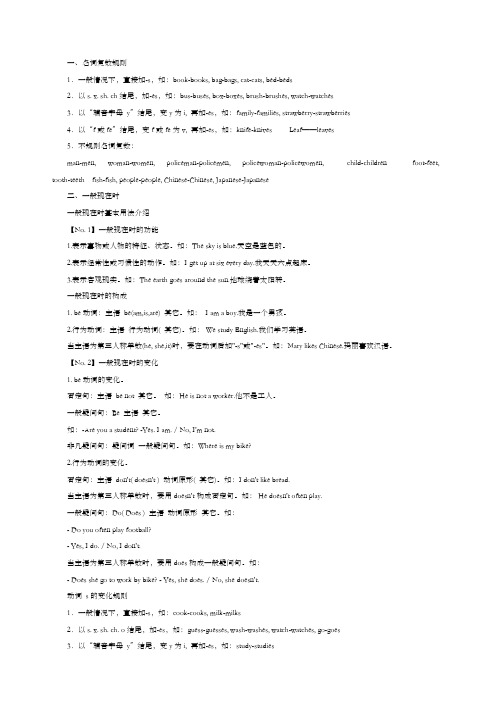
一、名词复数规则1.一般情况下,直接加-s,如:book-books, bag-bags, cat-cats, bed-beds2.以s. x. sh. ch结尾,加-es,如:bus-buses, box-boxes, brush-brushes, watch-watches3.以“辅音字母y”结尾,变y为i, 再加-es,如:family-families, strawberry-strawberries4.以“f或fe”结尾,变f或fe为v, 再加-es,如:knife-knives Leaf——leaves5.不规则名词复数:man-men, woman-women, policeman-policemen, policewoman-policewomen, child-children foot-feet, tooth-teeth fish-fish, people-people, Chinese-Chinese, Japanese-Japanese二、一般现在时一般现在时基本用法介绍【No. 1】一般现在时的功能1.表示事物或人物的特征、状态。
如:The sky is blue.天空是蓝色的。
2.表示经常性或习惯性的动作。
如:I get up at six every day.我天天六点起床。
3.表示客观现实。
如:The earth goes around the sun.地球绕着太阳转。
一般现在时的构成1. be动词:主语be(am,is,are) 其它。
如: I am a boy.我是一个男孩。
2.行为动词:主语行为动词( 其它)。
如: We study English.我们学习英语。
当主语为第三人称单数(he, she,it)时,要在动词后加"-s"或"-es"。
如:Mary likes Chinese.玛丽喜欢汉语。
【No. 2】一般现在时的变化1. be动词的变化。
- 1、下载文档前请自行甄别文档内容的完整性,平台不提供额外的编辑、内容补充、找答案等附加服务。
- 2、"仅部分预览"的文档,不可在线预览部分如存在完整性等问题,可反馈申请退款(可完整预览的文档不适用该条件!)。
- 3、如文档侵犯您的权益,请联系客服反馈,我们会尽快为您处理(人工客服工作时间:9:00-18:30)。
一、名词复数规则1.一般情况下,直接加-s,如:book-books, bag-bags, cat-cats, bed-beds2.以s. x. sh. ch结尾,加-es,如:bus-buses, box-boxes, brush-brushes, watch-watches3.以“辅音字母y”结尾,变y为i, 再加-es,如:family-families, strawberry-strawberries4.以“f或fe”结尾,变f或fe为v, 再加-es,如:knife-knives Leaf——leaves5.不规则名词复数:man-men, woman-women, policeman-policemen, policewoman-policewomen, child-children foot-fe et, tooth-teeth fish-fish, people-people, Chinese-Chinese, Japanese-Japanese二、一般现在时一般现在时基本用法介绍【No. 1】一般现在时的功能1.表示事物或人物的特征、状态。
如:The sky is blue.天空是蓝色的。
2.表示经常性或习惯性的动作。
如:I get up at six every day.我天天六点起床。
3.表示客观现实。
如:The earth goes around the sun.地球绕着太阳转。
一般现在时的构成1. be动词:主语be(am,is,are) 其它。
如:I am a boy.我是一个男孩。
2.行为动词:主语行为动词( 其它)。
如:We study English.我们学习英语。
当主语为第三人称单数(he, she,it)时,要在动词后加"-s"或"-es"。
如:Mary likes Chinese.玛丽喜欢汉语。
【No. 2】一般现在时的变化1. be动词的变化。
否定句:主语be not 其它。
如:He is not a worker.他不是工人。
一般疑问句:Be 主语其它。
如:-Are you a student?-Yes. I am. / No, I'm not.非凡疑问句:疑问词一般疑问句。
如:Where is my bike?2.行为动词的变化。
否定句:主语don't( doesn't ) 动词原形( 其它)。
如:I don't like bread.当主语为第三人称单数时,要用doesn't构成否定句。
如:He doesn't often play.一般疑问句:Do( Does ) 主语动词原形其它。
如:- Do you often play football?- Yes, I do. / No, I don't.当主语为第三人称单数时,要用does构成一般疑问句。
如:- Does she go to work by bike?- Yes, she does. / No, she doesn't.动词s的变化规则1.一般情况下,直接加-s,如:cook-cooks, milk-milks2.以s. x. sh. ch. o结尾,加-es,如:guess-guesses, wash-washes, watch-watches, go-goes3.以“辅音字母y”结尾,变y为i, 再加-es,如:study-studies三、现在进行时1.现在进行时表示现在正在进行或发生的动作,也可表示当前一段时间内的活动或现阶段正在进行的动作。
2.现在进行时的肯定句基本结构为be 动词ing.3.现在进行时的否定句在be后加not。
4.现在进行时的一般疑问句把be动词调到句首。
5.现在进行时的非凡疑问的基本结构为:疑问词不达意be 主语动词ing?但疑问词当主语时其结构为:疑问词不达意be 动词ing?动词加ing的变化规则1.一般情况下,直接加ing,如:cook-cooking2.以不发音的e结尾,去e加ing,如:make-making, taste-tasting 3.假如末尾是一个元音字母和一个辅音字母,双写末尾的辅音字母,再加ing,如:run-running, stop-stopping四、将来时理论及练习一、概念:表示将要发生的动作或存在的状态及打算、计划或预备做某事。
句中一般有以下时间状语:tomorrow, next day(week, month, year…),soon, the day after tomorrow(后天)等。
二、基本结构:①be going to do;②will do.三、否定句:在be动词(am, is, are)l后加not或情态动词will后加not成won’t。
例如:I’m going to have a picnic this afternoon.→I’m not going to have a picnic this afternoon.四、同义句:be going to = willI am going to go swimming tomorrow(明天). = I will go swimming tomorrow.五、一般过去时1.一般过去时表示过去某个时间发生的动作或存在的状态,常和表示过去的时间状语连用。
一般过去时也表示过去经常或反复发生的动作。
2.Be动词在一般过去时中的变化:⑴am 和is在一般过去时中变为was。
(was not=wasn’t)⑵are在一般过去时中变为were。
(were not=weren’t)3.句中没有be动词的一般过去时的句子否定句:didn’t 动词原形,如:Jim didn’t go home yesterday.动词过去式变化规则:1.一般在动词末尾加-ed,如:work__-worked , cook-cooked2.结尾是e加d,如:live____lived3.末尾只有一个元音字母和一个辅音字母的重读闭音节,应双写末尾的辅音字母,再加-ed,如:stop-stopped4.以“辅音字母y”结尾的,变y为i,再加-ed,如:study-studied 5.不规则动词过去式:am,is-was, are-were, do-did, see-saw, say-said, give-gave, get-got, go-went, come-came, have-had, eat-ate, take-took, run-ran, sing-sang, put-put, make-made, read-read, write-wrote, draw-drew, drink-drank, swim-swam, sit-sat六、人称代词和物主代词主格宾格形容词性名词性I me my mineyou you your yourshe him his hisshe her her hersit it its itswe us our ours具体用法1.Hello 的用法:Hello 的意思为“您好”,一般可作为熟人,亲朋好友之间的打招呼用语,语气比较随便,例如:Hello,Li Hua!你好,李华。
Hello,Tom!你好,汤姆!Hello 也可以用以引起某人注意,常用在打电话时或者在路上碰见熟人时,相当于中文中的“喂”,有时也可用Hi 来代替hello ,但前者显得更随便。
2.What's your name?的用法:当两人初次见面互相询问姓名时,可用What's your name?来提问,回答时,可用My name is ….来回答,接着反问对方时,可用And what's your name?来提问。
例如:Hi!What's your name? 你好,你叫什么名字?Hi!My name is Lucy.And what's your name? 你好,我叫露西。
你叫什么名字?My name is Wang Ying. 我叫王英。
句中的What's是What is的缩写形式。
3.Good morning,class (teacher).的用法:Good morning,class.同学们好。
Good morning,teacher.老师好。
这是上午上课时,老师和全班同学互相问候时用语。
Good morning 是上午问候时的用语,多用于熟人,朋友或家人之间,是比较正式的问候用语。
句中问候语放在前面,称呼语则要放在后面,并用逗号隔开。
例如:Good morning.Mr.White.怀特先生,你好。
4.英语字母:英语中有26个字母,每一字母有大写形式和小写形式两种。
大小写形式如下:A aB bC cD dE eF fG gH hI IJ j K k L l M m N n O o P p Q q R rS s T t U u V v W w X x Y y Z z1.Are you…?的用法。
这是一疑问句型,意思是“你是……吗?”用来询问姓名,职业,身份等,例如:Are you a worker?你是一名工人吗?Are you a student?你是学生吗?回答时用Yes,I am.(是的,我是。
)或者No,I'm not.(不,我不是)来回答,注意Yes和No后面都有逗号,不能省略。
2.Nice to meet you.的用法:这是两位初次见面相识后的用语,意思是“见到你很高兴。
”见面相识可由自我介绍,第三者介绍或者询问相识。
例如:Hello!I'm Xiao Hua. 你好,我是小华Hello!I'm Xiao Li. 你好,我是小李。
Nice to meet you,Xiao Li. 小李,见到你我很高兴。
Nice to meet you,too,Xiao Hua. 小华,见到你我也很高兴。
3.Where is …?的用法:这一句型表示“某物或某人在什么地方”。
它同中文的句型结构不一样,where在前,而某物或某人在后,例如:Where is my book? 我的书在哪儿?It's there. 在这儿。
Where is Tom? Tom在哪儿?He is here. 他在这儿。
句中的where is可以缩写成“where's”。
4.am,is和are 的用法:这三个词都是“是”的含义,但用法比中文中的“是”要复杂,英语中的am,is 和are都是be 的变化形式,根据不同的主语选用不同的动词,主语I 用am,表示复数的主语和单数“you”则要用are,其它则用is。
